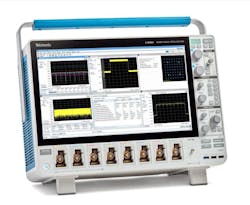Oscilloscopes Add 5G NR Analysis Software
Tektronix released SignalVu 5G NR analysis software for their 6 Series B MSO oscilloscopes to perform critical 5G NR measurements per 3GPP specifications. IN addition to providing a time-coherent view of the choreography of signals related to a design, it also includes important signal quality measurements such as Error Vector Magnitude (EVM), Adjacent Channel Power (ACP), Spectral Emission Mask (SEM), and Power Versus Time (PVT).
The analysis package enables pass/fail testing of the 5G NR physical layer to qualify transmitter designs per the 5G NR standard established under the 3GPP release of 15/16 test specifications. The 5G NR PHY-layer solution based on the Tektronix 6 Series B MSO offers signal analysis up to 2 GHz and low instrument noise for accurate EVM measurements. For high frequency systems, the 5GNR analysis option is also available on the DPO70000SX which offers up to 70 GHz bandwidth. The 5GNR option is also available for the Tektronix RSA500 and RSA5000 Series, and operates identically on oscilloscopes and signal analyzers.
About the Author
Alix Paultre
Editor-at-Large, Microwaves & RF
Alix is Editor-at-Large for Microwaves & RF.
An Army veteran, Alix Paultre was a signals intelligence soldier on the East/West German border in the early ‘80s, and eventually wound up helping launch and run a publication on consumer electronics for the U.S. military stationed in Europe. Alix first began in this industry in 1998 at Electronic Products magazine, and since then has worked for a variety of publications, most recently as Editor-in-Chief of Power Systems Design.
Alix currently lives in Wiesbaden, Germany.

